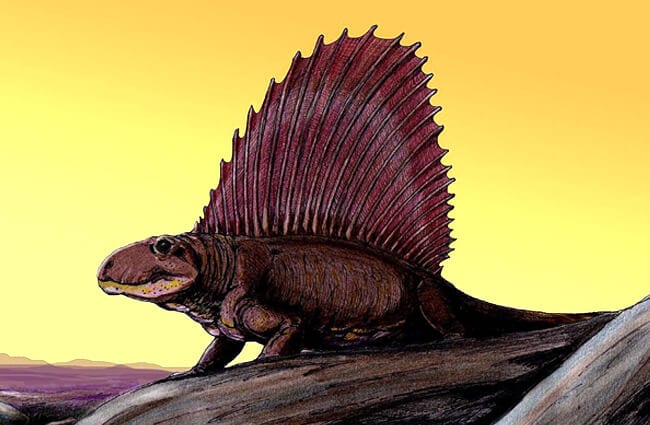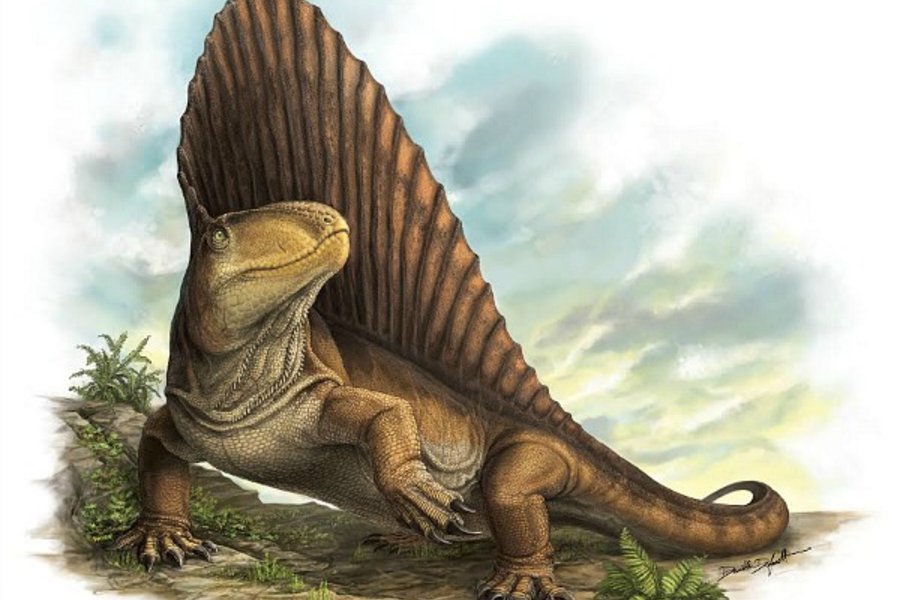Solar Dimetrodon
Dimetrodon was a species of synapsid that went extinct around 272 million years BDF during the Permian period. Its descendants were among the creatures that eventually evolved into mammals, and became famous long before the Day of Fate due to its unique sailed appearance. When the Day of Fate happened, the knowledge of Dimetrodon and other famous extinct animals were lost to almost everybody. Only two cities still know of the Permian Dimetrodon. During the millennia when the earth recovered many creatures evolved, but some did so backwards. And creatures we believe were rats quickly de-evolved to their Permian stage: the Dimetrodon. The first one appeared around 5981 PDF in what used to be the Netherlands, and in no time the species was back and stable.
Eventually they had spread to what used to be France. Around this time the sun tree had started to appear in the area. The Dimetrodon population eventually found themselves adapting to the jungle biome. And adapt they did. A Dimetrodon uses the large sail on its back to bask in the sun to warm its cold-blooded body, and when the area got covered in large trees blocking out the sun they found themselves unable to raise their body temperature consistently. So over the generations they slowly adapted to absorbing heat from the air around them instead of directly from the sun. One Dimetrodon was born with a species-definining mutation though. Its back was covered in large crystal-like bumps made of hardened skin. These functioned like storages for solar energy which it could freely draw from if it was without heat for long enough. But not only that, it could also expel the stored heat from its mouth with much force at a high enough temperature that the air around it combusted. Or in simple terms, it could breathe fire. These traits carried on and evolved, and Dimetrodon with these traits outclassed Dimetrodon without them. The current generation has more defined and less bumpy skin patches and the blasts are hot and focused enough to create a large focused beam instead of a flaming stream. The subspecies was now distinct enough to be classified as its own genus: Dimetrodon Solaris, or Solar Dimetrodon.
Eventually they had spread to what used to be France. Around this time the sun tree had started to appear in the area. The Dimetrodon population eventually found themselves adapting to the jungle biome. And adapt they did. A Dimetrodon uses the large sail on its back to bask in the sun to warm its cold-blooded body, and when the area got covered in large trees blocking out the sun they found themselves unable to raise their body temperature consistently. So over the generations they slowly adapted to absorbing heat from the air around them instead of directly from the sun. One Dimetrodon was born with a species-definining mutation though. Its back was covered in large crystal-like bumps made of hardened skin. These functioned like storages for solar energy which it could freely draw from if it was without heat for long enough. But not only that, it could also expel the stored heat from its mouth with much force at a high enough temperature that the air around it combusted. Or in simple terms, it could breathe fire. These traits carried on and evolved, and Dimetrodon with these traits outclassed Dimetrodon without them. The current generation has more defined and less bumpy skin patches and the blasts are hot and focused enough to create a large focused beam instead of a flaming stream. The subspecies was now distinct enough to be classified as its own genus: Dimetrodon Solaris, or Solar Dimetrodon.
Heat storage and release
The skin patches function more or less as solar panels for the creature. They absorb the heat in the air around the Dimetrodon to keep a high body temperature and can store extra heat themselves. From there it's regulated throughout the body so it can function properly. The patches can hold energy that at its most could fuel a large furnace for several days, and if the Dimetrodon were to end up in a cold area it automatically draws from these reserves in order to stay warm for up to 22 hours at full capacity. But the Solar Dimetrodon's most surprising ability is to use the stored energy as offense. It can focus part of its heat reserves in its throat and then exhale to release a large focused heat beam from its mouth by igniting the air in front of it. This beam can at full power reach up to 60 ft. until it dissipates and reach up to 1200 °C hot, enough to burn anything in its natural habitat to a crisp. While using it, the skin patches and sail glow bright orange and heat up to around 600 °C. Naturally the Dimetrodon's body and especially the mouth is extremely heat resistant so as not to burn itself up while using the beam, but overuse of it has led to burn marks and cracked teeth. Therefore it only uses the heat beam in a serious confrontation. The Dimetrodon can also exhale in quick bursts to release smaller heat projectiles at multiple targets. It isn't fully known what causes the heat to take and keep the form of a focused beam, but it's speculated that magic is involved to some degree.
Basic Information
Anatomy
A Dimetrodon is a quadrupedal mammal covered in smooth skin instead of fur. The four legs are placed on the side of the body similar to a reptile, but it moves without swaying the back similar to a mammal. The skull is short and robust and it has two types of teeth, both short and long. On its back is a sail made up of several long spines with a thick skin membrane connecting them. A Solar Dimetrodon also has patches of very smooth and shiny hardened black skin, giving the appearance of glass disks across its back.
Genetics and Reproduction
The entire Dimetrodon genus lays eggs similar to a reptile, and the Solar Dimetrodon is no different. Females get fertilized during mating season in late autumn, and after the winter hibernation she lays a batch of up to 15 eggs. The female stays by the nest during the 6 month period before they hatch to protect them from predators, but despite this usually only 3-4 eggs end up hatching.
Growth Rate & Stages
Dimetrodon hatch from clutches of eggs and are looked after by their mother for the first month. After that they are viewed as prey by her and live on their own. They grow quickly for the first 5 years of their life until they are about 2 meters in length. At that point their growth slows down, and they reach full adult size at about 14 years of age. At birth the sail is not present. It starts to grow after about 2 years into the Dimetrodon's life and reaches full size when the rest of the Dimetrodon does. The solar patches are present from birth though, but grow sturdier during the first 4 years where they are fully formed.
Ecology and Habitats
A Solar Dimetrodon needs to live in hot areas of at least 20 °C to function properly. Therefore the entire population is restricted to the french jungle since they can't migrate or come that far without freezing. It's theorized they could live normally on savannahs or even deserts, but given their coloration and diets the jungle seems like the best fit.
Dietary Needs and Habits
The Solar Dimetrodon is a carnivore just like a regular Dimetrodon. Since it isn't very fast it mainly attacks either large slow creatures or smaller creatures from ambush, usually creatures around 0.5 meters in length. During hunts it mainly bites down on the target's neck or other weak spots in order to kill it fast. It very rarely uses its heat beam during hunting due to the large energy requirements behind it, so it remains as purely a combat function.
Biological Cycle
During winter season the sun tree sheds its leaves and the general temperature in the area drops. During this time the Solar Dimetrodon go into hibernation, living on their stored body heat and expends as little energy as possible. Before winter the Dimetrodon makes sure to eat enough to survive three months of hibernation similar to bears. When the sun tree's leaves come back the Solar Dimetrodon wakes up to immediately go hunting again.
Additional Information
Social Structure
The Solar Dimetrodon live in packs of about 6-10 individuals. Since they are not territorial animals conflicts between packs are rare outside of mating season. When mating season does occur the males in the pack get more aggressive and fights between them occur frequently, and these almost always result in scorchmarks and small fires in the area. The winner of the fight gets the right to impress the females and eventually mate with one. Mating and fighting isn't limited to one pack; males from two different packs can fight over a female from a third pack. Outside of mating season a Solar Dimetrodon pack is usually very docile towards each other. They stick together for protection, but if one gets attacked the others don't defend it.
Geographic Origin and Distribution
The Solar Dimetrodon lives exclusively in the jungle covering most of France. Regular Dimetrodon live across the entirety of northwest Europe, but the Solar Dimetrodons high temperature requirement limit them to only this area.
Average Intelligence
A Dimetrodon, and by extension a Solar Dimetrodon, has a relatively small brain for its body size. Therefore it is not very smart for a mammal, about the same level as the now extinct elephant.
Symbiotic and Parasitic organisms
Due to their geographical distribution and high temperature requirements, the Solar Dimetrodon is very specific with its habitary needs. Since the sun tree emits enough heat to make France into a tropical zone in the otherwise cold temperate, it's the reason the Solar Dimetrodon is still alive. Many animals in the french jungle is dependant on the sun tree, but none as much as the Solar Dimetrodon. If the sun tree would disappear so would the Solar Dimetrodon.
Scientific Name
Dimetrodon Solaris
Origin/Ancestry
Netherlands
Lifespan
40 years
Average Height
0.7 meters
Average Weight
150 kg
Average Length
3 meters
Body Tint, Colouring and Marking
Brown with a yellow underbelly and black hardened spots on the back around the sail. The sail itself is brown with red spots, but becomes brighter and more saturated during mating season.




Comments